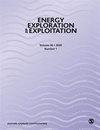The role of mining-induced seismicity amplitude and frequency in gob-side roadway rib spalling
IF 1.6
4区 工程技术
Q4 ENERGY & FUELS
引用次数: 0
Abstract
During underground coal mining, Mining-induced seismicity is a crucial factor leading to roadway deformation. Based on a case study of rib spalling caused by mining-induced seismicity in China, this paper utilizes the Universal Distinct Element Code to investigate the mechanism of rib spalling. It analyzes the stress evolution process of roadway surrounding rock and the damage process under the influence of mining-induced seismicity. Additionally, it examines the relationship between seismic wave amplitude, frequency and the damage characteristics of roadway surrounding rock. Findings show that seismic waves induce stress concentration zones in the deeper surrounding rock, causing shear failure, while stress concentration zones emerge in the top, bottom and shoulders of roadway, leading to tensile failure in the shallower surrounding rock. With increasing seismic wave amplitude, the critical crack length of surrounding rock decreases, resulting in a linear increase in crack count and distribution area. The roadway exhibits a ‘n'-shaped damage profile primarily driven by shear failure. With increasing seismic wave frequency, the crack count in the surrounding rock of the roadway exhibits a trend of initially increasing and then decreasing. This trend becomes more pronounced with larger amplitudes. Rib spalling damage is influenced by seismic wave frequency and amplitude: frequencies of 20–25 Hz and 80–100 Hz require amplitudes exceeding 3 m for damage, while 25–30 Hz and 55–80 Hz require amplitudes over 2 m, and 30–55 Hz necessitate amplitudes exceeding 1.5 m.采矿引起的地震振幅和频率在巷道边肋剥落中的作用
在地下煤矿开采过程中,采矿诱发地震是导致巷道变形的关键因素。本文以中国采矿诱发地震引起的肋骨剥落为例,利用通用特殊元素代码研究了肋骨剥落的机理。本文分析了巷道围岩的应力演化过程以及在矿山诱发地震影响下的破坏过程。此外,还研究了地震波振幅、频率与巷道围岩破坏特征之间的关系。研究结果表明,地震波在较深的围岩中引起应力集中区,导致剪切破坏,而在巷道顶部、底部和路肩出现应力集中区,导致较浅围岩的拉伸破坏。随着地震波振幅的增加,围岩的临界裂缝长度减小,导致裂缝数量和分布面积呈线性增加。巷道呈现出 "n "形破坏剖面,主要由剪切破坏引起。随着地震波频率的增加,巷道围岩中的裂缝数量呈现出先增加后减少的趋势。振幅越大,这种趋势越明显。肋骨剥落破坏受地震波频率和振幅的影响:频率为 20-25 Hz 和 80-100 Hz 的破坏要求振幅超过 3 米,而频率为 25-30 Hz 和 55-80 Hz 的破坏要求振幅超过 2 米,频率为 30-55 Hz 的破坏要求振幅超过 1.5 米。
本文章由计算机程序翻译,如有差异,请以英文原文为准。
求助全文
约1分钟内获得全文
求助全文
来源期刊

Energy Exploration & Exploitation
工程技术-能源与燃料
CiteScore
5.40
自引率
3.70%
发文量
78
审稿时长
3.9 months
期刊介绍:
Energy Exploration & Exploitation is a peer-reviewed, open access journal that provides up-to-date, informative reviews and original articles on important issues in the exploration, exploitation, use and economics of the world’s energy resources.
 求助内容:
求助内容: 应助结果提醒方式:
应助结果提醒方式:


